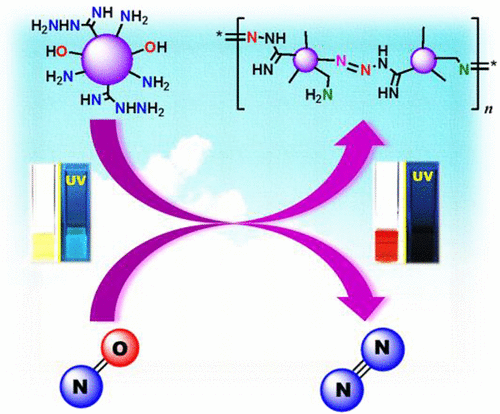Our official English website, www.x-mol.net, welcomes your
feedback! (Note: you will need to create a separate account there.)
Nitric Oxide Sensing through Azo-Dye Formation on Carbon Dots
ACS Sensors ( IF 8.2 ) Pub Date : 2017-08-16 00:00:00 , DOI: 10.1021/acssensors.7b00356 Sagarika Bhattacharya 1 , Rhitajit Sarkar 1 , Biswarup Chakraborty 1 , Angel Porgador 1 , Raz Jelinek 1
ACS Sensors ( IF 8.2 ) Pub Date : 2017-08-16 00:00:00 , DOI: 10.1021/acssensors.7b00356 Sagarika Bhattacharya 1 , Rhitajit Sarkar 1 , Biswarup Chakraborty 1 , Angel Porgador 1 , Raz Jelinek 1
Affiliation

|
Carbon dots (C-dots) prepared through heating of aminoguanidine and citric acid enable bimodal (colorimetric and fluorescence) detection of nitric oxide (NO) in aqueous solutions. The C-dots retained the functional units of aminoguanidine, which upon reaction with NO produced surface residues responsible for the color and fluorescence transformations. Notably, the aminoguanidine/citric acid C-dots were noncytotoxic, making possible real-time and high sensitivity detection of NO in cellular environments. Using multiprong spectroscopic and chromatography analyses we deciphered the molecular mechanism accounting for the NO-induced structural and photophysical transformations of the C-dots, demonstrating for the first time N2 release and azo dye formation upon the C-dots’ surface.
中文翻译:

碳点上偶氮染料形成对一氧化氮的传感
通过加热氨基胍和柠檬酸制备的碳点(C-点)能够对水溶液中的一氧化氮(NO)进行双峰(比色和荧光)检测。C点保留氨基胍的功能单元,其与NO反应后产生负责颜色和荧光转换的表面残基。值得注意的是,氨基胍/柠檬酸C点无细胞毒性,因此可以在细胞环境中实时,高灵敏度地检测NO。使用多管光谱和色谱分析,我们解释了分子机理,解释了NO诱导的C点的结构和光物理转变,首次证明了N 2的释放和C点表面上偶氮染料的形成。
更新日期:2017-08-16
中文翻译:

碳点上偶氮染料形成对一氧化氮的传感
通过加热氨基胍和柠檬酸制备的碳点(C-点)能够对水溶液中的一氧化氮(NO)进行双峰(比色和荧光)检测。C点保留氨基胍的功能单元,其与NO反应后产生负责颜色和荧光转换的表面残基。值得注意的是,氨基胍/柠檬酸C点无细胞毒性,因此可以在细胞环境中实时,高灵敏度地检测NO。使用多管光谱和色谱分析,我们解释了分子机理,解释了NO诱导的C点的结构和光物理转变,首次证明了N 2的释放和C点表面上偶氮染料的形成。











































 京公网安备 11010802027423号
京公网安备 11010802027423号